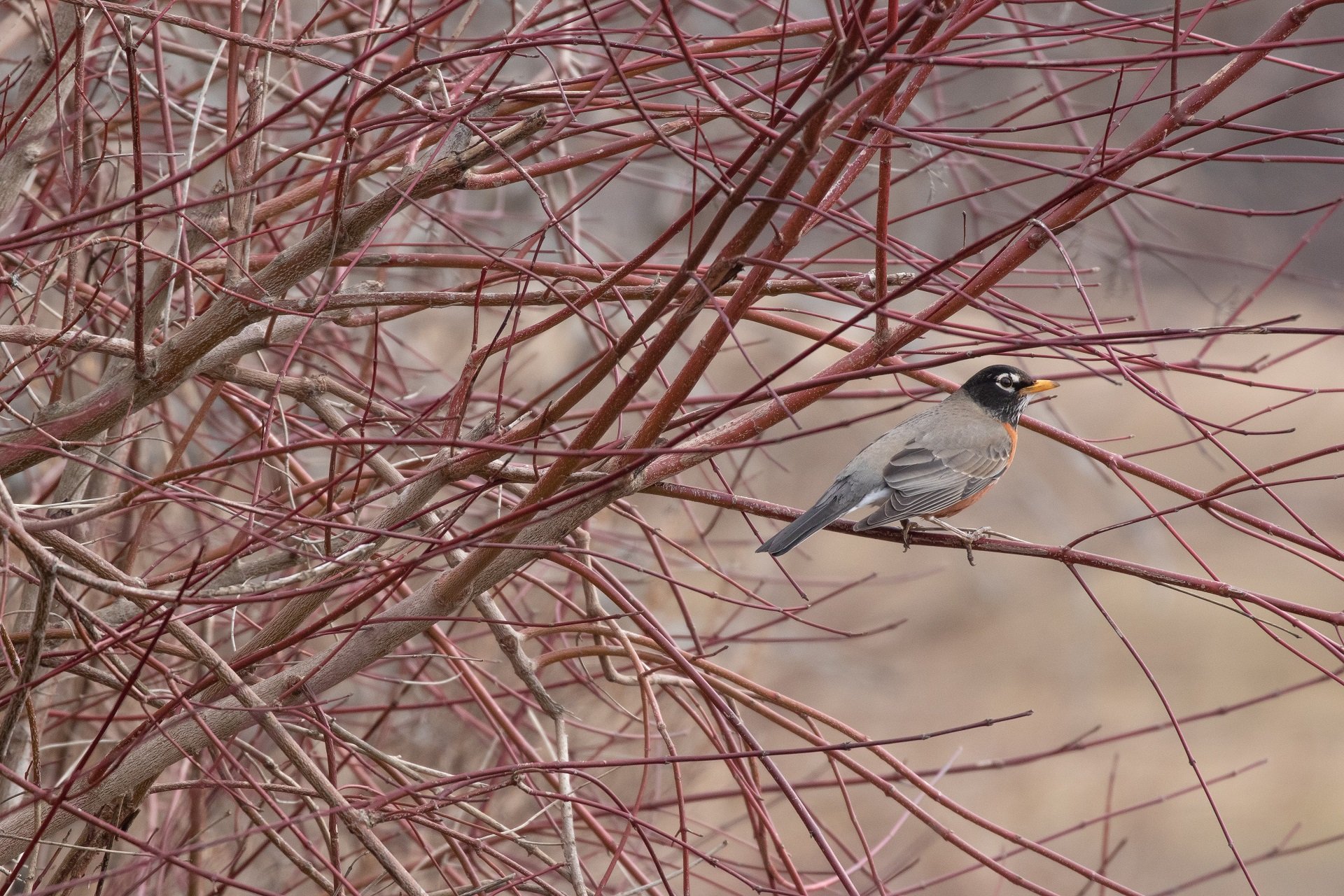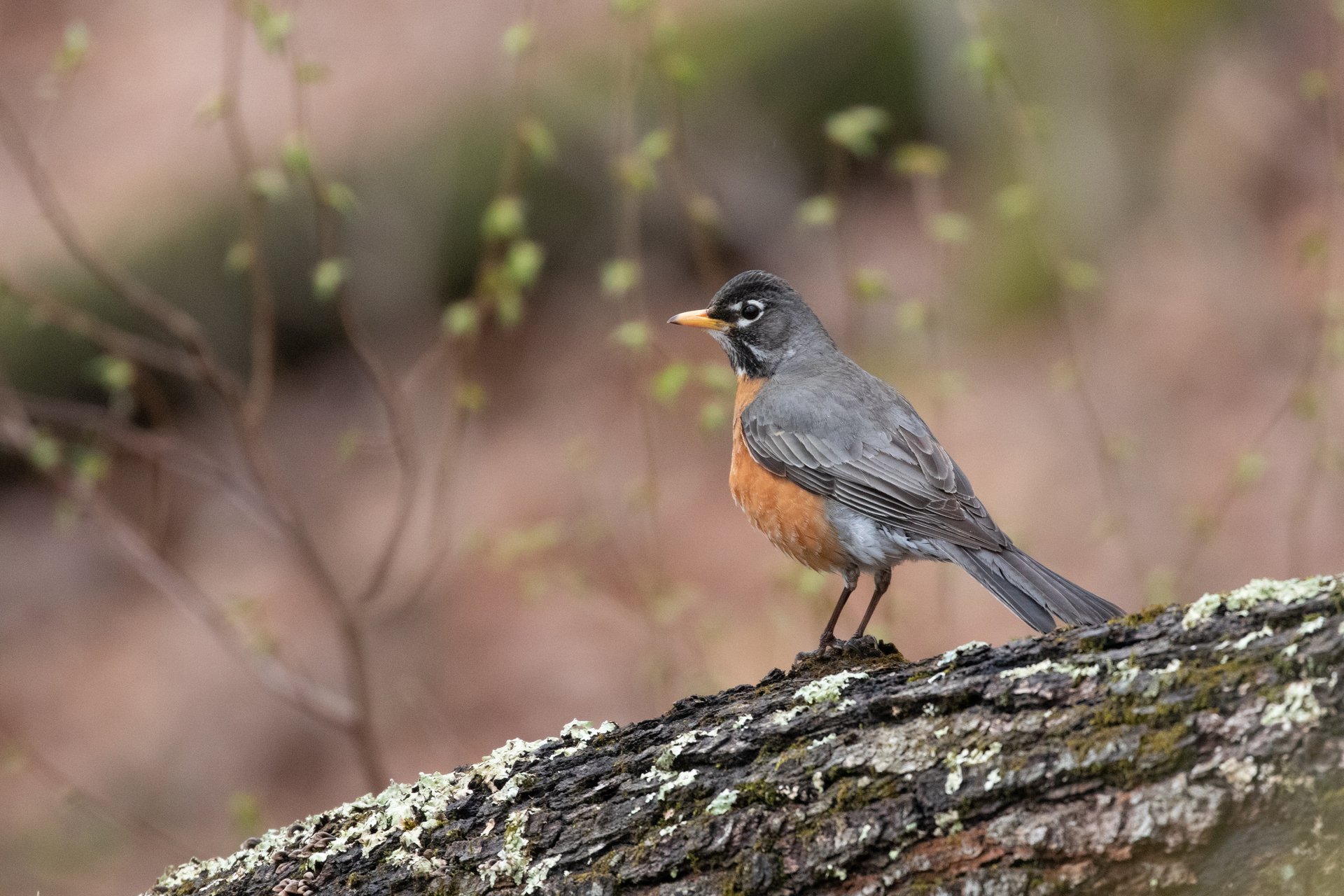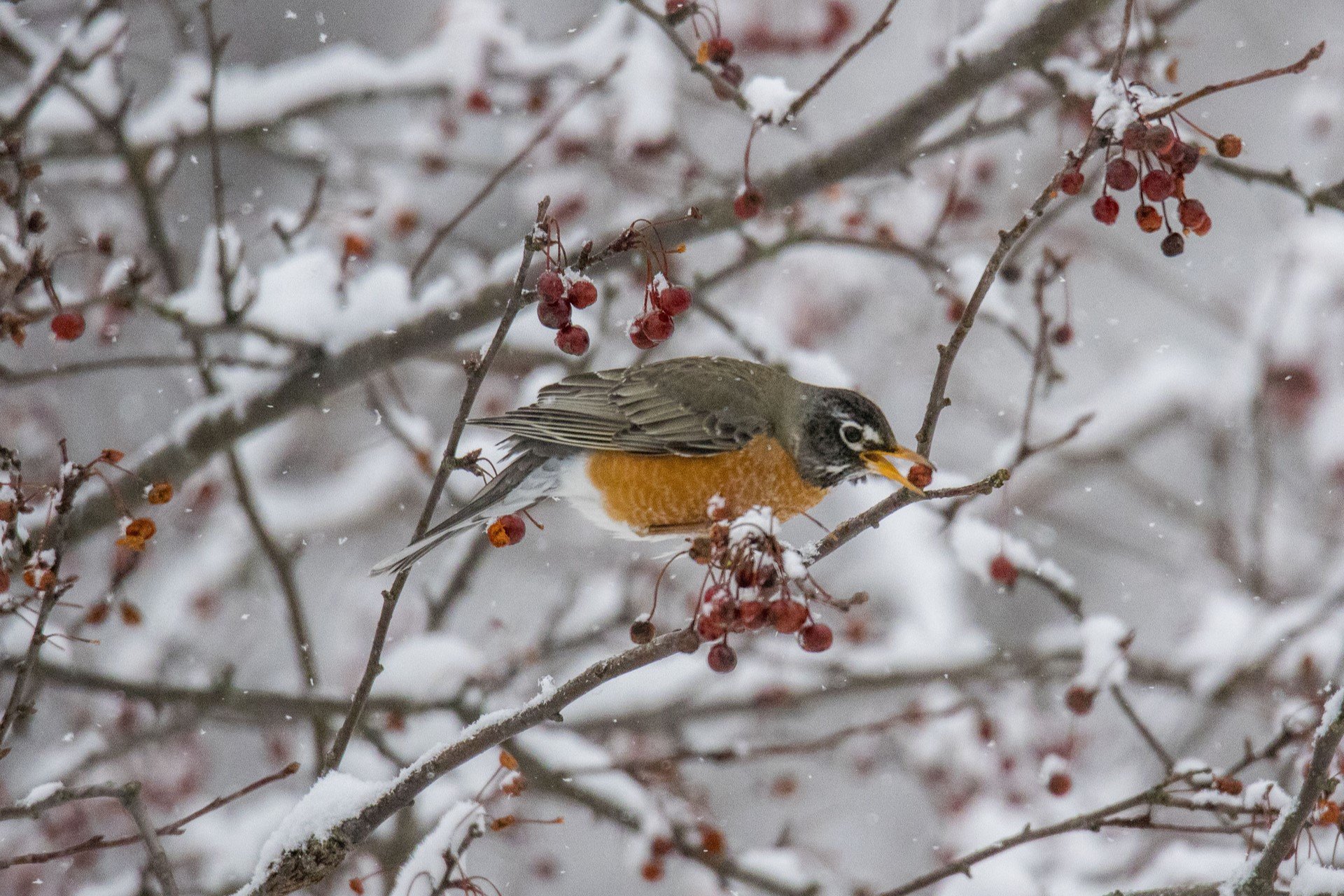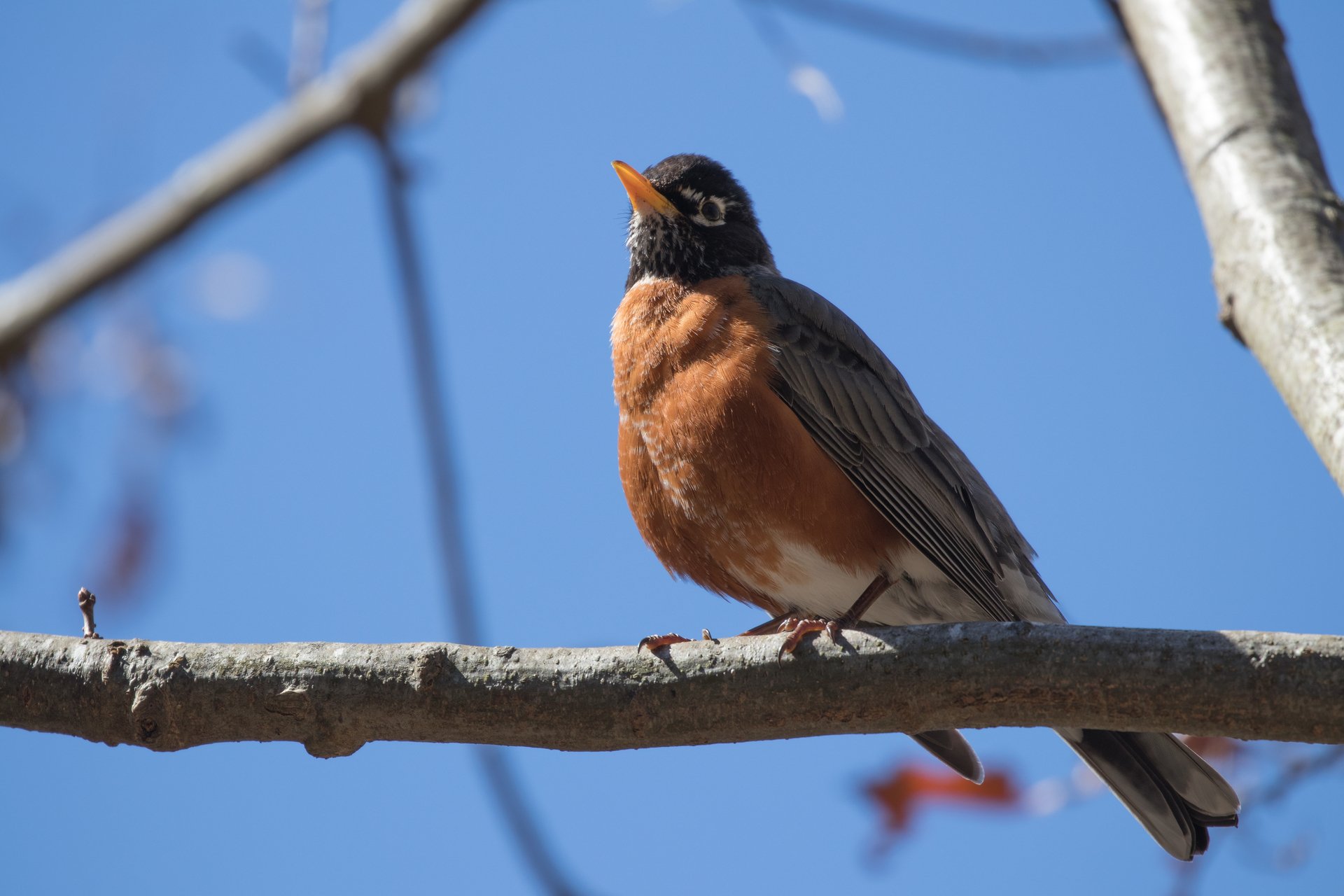American Robins
American Robins (Turdus migratorius) are one of the most familiar feathered friends in all of North America. Among the earliest avian vocalizers each spring, you can often hear them singing before dawn and late into sunset. Their iconic red breast and yellow bill make them easy to recognize and admire.
How to Identify American Robins
American Robins Male vs Female
Both males and females have yellow bills and are grey above with an orange to brick-red breast below. Very young robins will show a speckled breast rather than the adult red. When a robin flies, it shows two small white tips at the corners of its dark tail. Full-grown adults are about 10 inches long, the largest thrush in Massachusetts.
Females and males may be very similar in their appearance, but your best chance at determining sex will be from behavior. A female will be the individual making the nest, incubating, and quietly calling to her male counterpart. A male will sing loudly and display his tail and wings for his mate. Males will also roost with other males and juveniles at night, while females remain with their eggs and nestlings.
American Robin Life Cycle
Robin Eggs
A typical brood contains 3-5 blue eggs, and incubation lasts approximately 12-14 days. Robins can have up to three broods in one breeding season. Both the male and female are involved in feeding, raising, and protecting the chicks until they are old enough to forage for themselves.
Robin Nests
Robin nests are commonly built in trees and shrubs (preferably coniferous), usually 10-25 feet high. They’ll occasionally nest on porches, sheltered windowsills, and the eaves of buildings. Because robin nests are fairly large and so well built, they are one of the easiest to spot after nesting season.
Female robins build their nests from the inside out. First, they use their wings to form a compact cup out of dead grass and twigs. Next, mud is added for reinforcement and the cup is lined with fine, dry grass. The finished product can take anywhere from 2-6 days to construct, depending on the weather.
Female brown-headed cowbirds sometimes lay their eggs in robin nests. This survival strategy, known as “brood parasitism,” allows cowbirds to flourish while the robins do all the work.
Do Robins Migrate?
In general, the summer range of robins extends from the tree limit in northern North America to southern Mexico, and the winter range covers southern Canada to Guatemala.
Most of the robins that breed in Massachusetts migrate to the southern states with the onset of cold weather in the fall. However, some robins may still be found in Massachusetts during the winter.
Where Do Robins Go in the Winter?
Although many robins do spend the winter in Massachusetts, these are not necessarily the same robins that we see here in summer. It’s more likely that robins wintering in Massachusetts migrate here from northern New England or Canada.
The number of wintering robins we see depends largely on the severity of the weather and the abundance of food. Most birds that regularly winter in New England are well suited to withstand cold temperatures, having grown additional feathers for insulation during the fall.
American Robin Behavior
Robins do most of their feeding and foraging on the ground, where they will run or hop for several short steps and then often assume an erect posture, always on the lookout for possible danger. During winter and migration especially, robins often travel in flocks. It's not unusual to see a dozen or more birds foraging on the same lawn or perching in the same tree.
Aggressive Behavior in American Robins
Nearly all birds will display aggressive behavior when they perceive a threat to their nest or young. Birds that nest near people, like the American Robin, are the most frequent assailants—harassing, people, domestic animals, and other birds.
Defensive behavior toward people can take the form of loud vocalizations, feigning injury, or pursuing or attacking the intruder. Birds are most aggressive towards humans during the nestling period (the interval between hatching and the young bird's departure from the nest), a span of about two weeks in common backyard nesters.
If an American Robin is displaying aggressive behavior towards you, patience and understanding are key. Remember, the behavior will last only as long as the young are in the nest, about two weeks. In the meantime, if possible, stay out of the area around the nest.
American Robin Song
The territorial song of the robin—a loud and continuous rich caroling, rising and falling in pitch and usually described as cheerily-cheerily-cheerily-cheerrio—is first heard on warm mornings in late March and early April.
Dawn and dusk choruses reach a peak in late April but continue, gradually diminishing in intensity, through mid-July. The familiar call notes of the robin, often rendered kwee-kwee-kuk-kuk-kuk or sometimes puck-kuk-kuk-kuk, are uttered with emphatic jerks of the tail and at varying speeds and intensity of delivery, depending on the bird’s emotional state.
The flight call, a thin see-lip, may be heard at any time of the year.
What Do American Robins Eat?
During the warmer months, a robin with an earthworm in its beak is a familiar sight. In the mornings, robins focus on finding worms and other proteins (ground-dwelling larvae, caterpillars, grasshoppers, beetles), and when this activity dies down, they shift their focus to fruits in the afternoons.
In winter, robins are nomadic. They fly in flocks and eat the berries of trees and shrubs that hold their fruit through the winter, including red cedar, American holly, hawthorn, and certain dogwood and crab apple species. As they deplete the food sources in one location, they’ll move on in search of a new supply.
Rarely, robins have been recorded consuming larger prey, such as snakes and shrews.
Where Can I See American Robins?
American Robins can be found in your backyard and beyond! Overall, their numbers in Massachusetts have greatly increased throughout the last century, and they can be found from the Cape to the Berkshires and everywhere in between.
How Mass Audubon is Supporting Birds in Massachusetts
Mass Audubon works at our wildlife sanctuaries and beyond to ensure that the nature of Massachusetts continues to thrive. By scientifically monitoring Massachusetts birdlife, Mass Audubon informs important conservation decisions and launches targeted initiatives to help at-risk species. In addition, fostering healthy habitats, supporting native species, and educating people about the importance of nature conservation is critical to our success. Learn more about our work
How You Can Support Birds in Massachusetts
Mass Audubon supports birds like the American Robin every day, but we couldn’t do it without the support of our 160,000+ members.
Help us support the American Robin, and birds like them, by becoming a member today.
Upcoming Bird Programs
Spring Migration Bird Walk
-
Greylock Glen, Adams
-
Wednesday, April 23
7:00-8:30am
Adults
Wednesday Morning Birding
-
Newburyport and vicinity
-
Wednesday, April 23
9:30am-12:30pm
Adults
Rescue Northern Berkshires Wildlife from Rodenticides
-
Wednesday, April 23
6:00-7:30pm
Adults
Stay Connected
Don't miss a beat on all the ways you can get outdoors, celebrate nature, and get involved.






